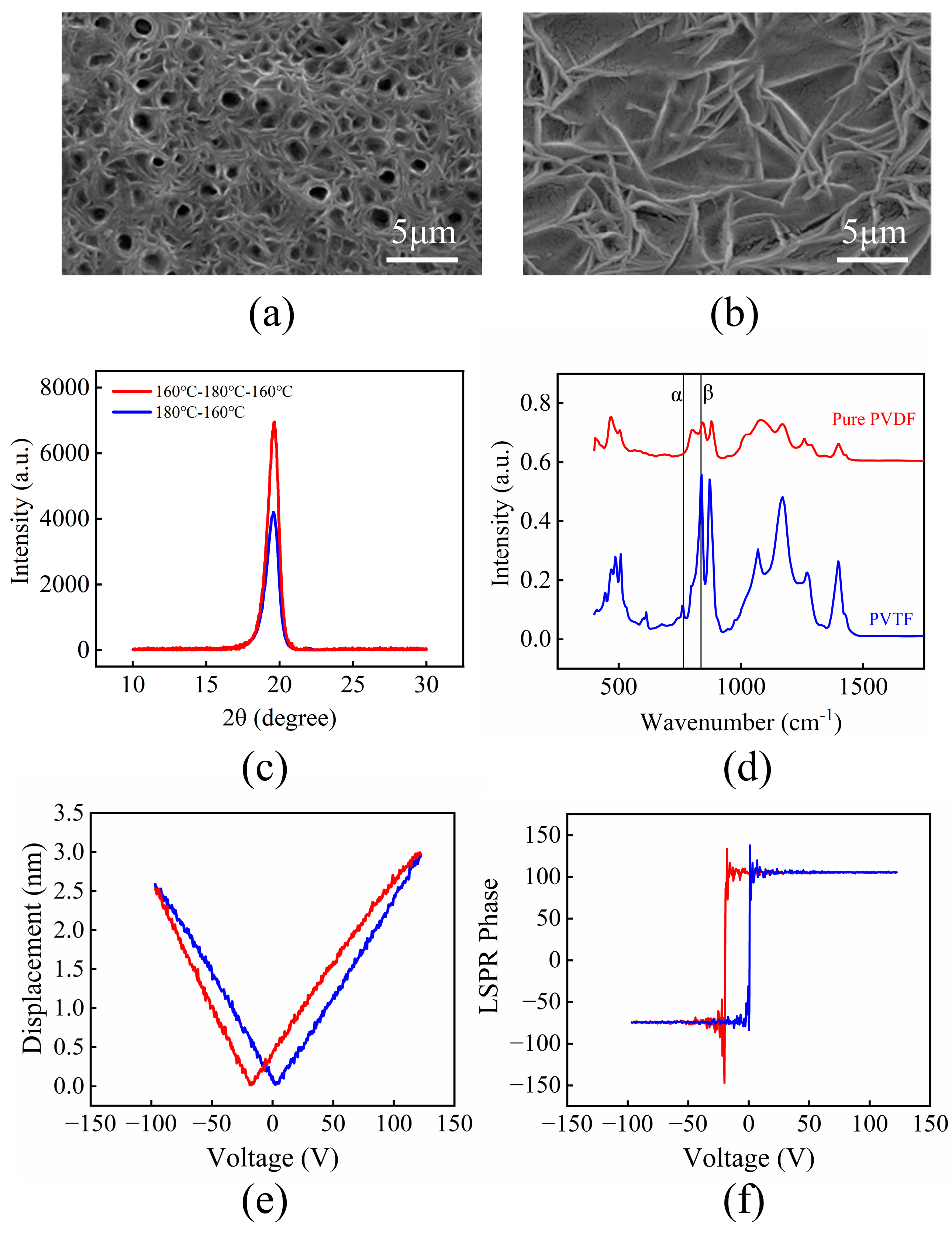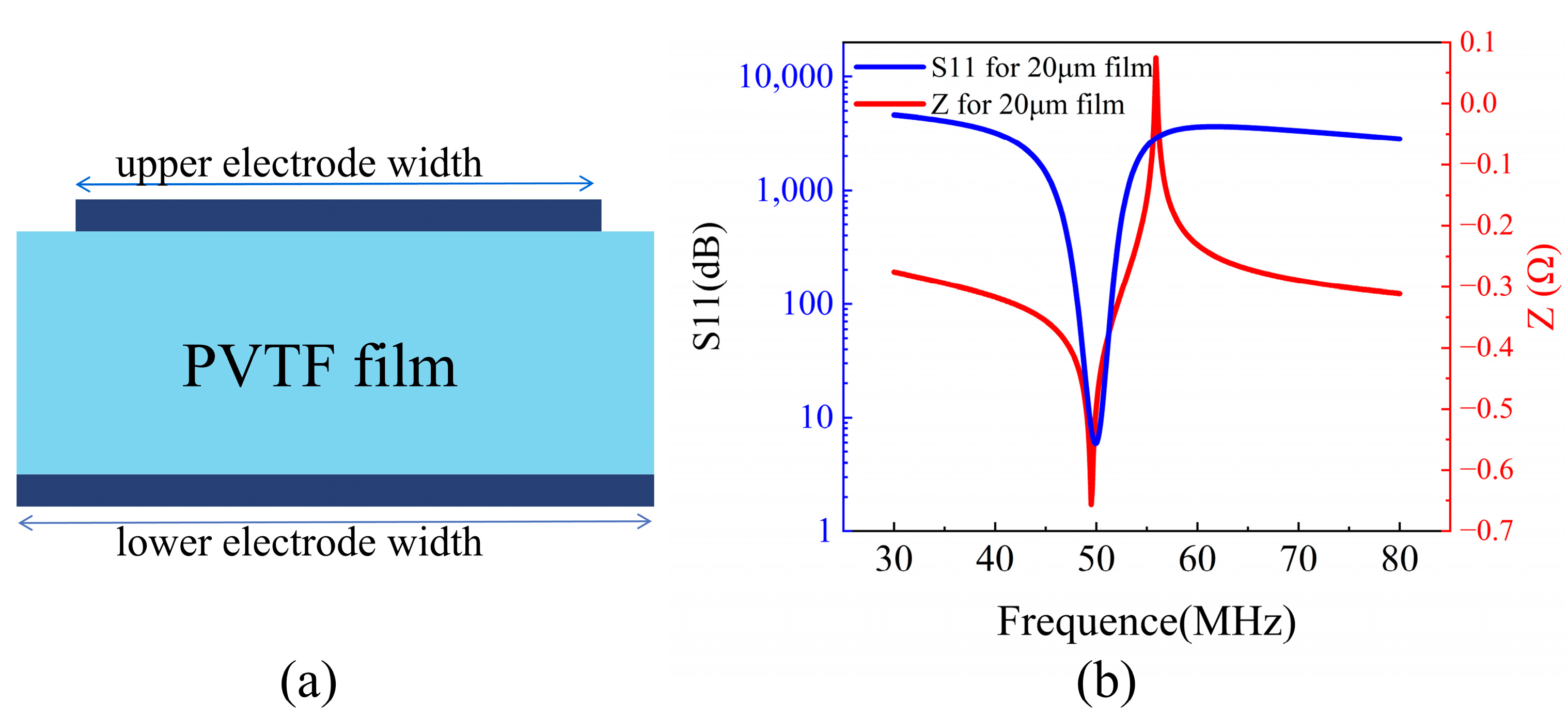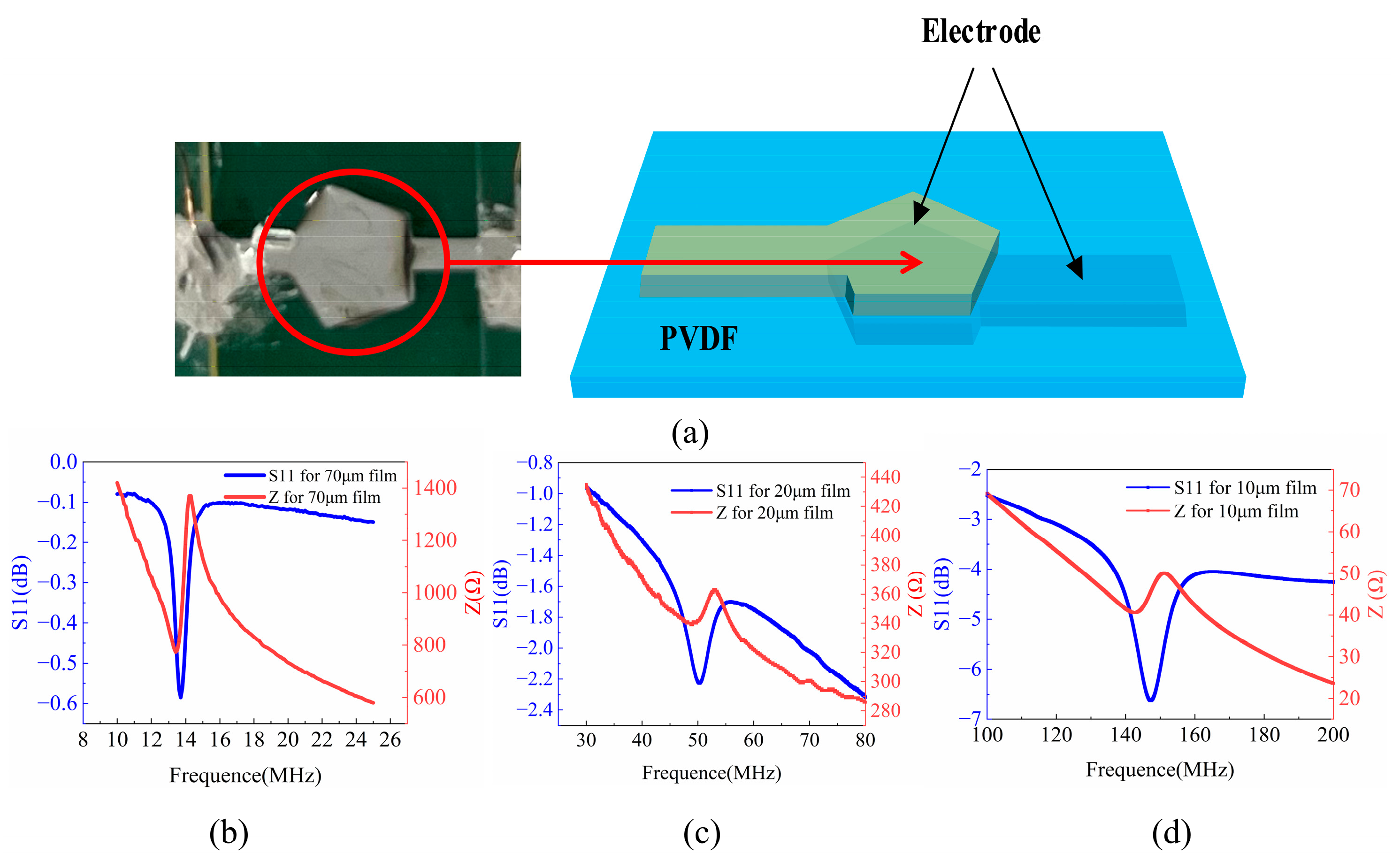Flexible Film Bulk Acoustic Wave Filter Based on Poly(vinylidene fluoride-trifluorethylene)
Abstract
1. Introduction
2. P(VDF-TrFE) Film Fabrication
2.1. Preparation of P(VDF-TrFE) Thin Films
2.2. Characterization of P(VDF-TrFE) Thin Films
3. P(VDF-TrFE) BAW RF Filters
3.1. Design and Simulation of High kt2 P(VDF-TrFE) BAW Resonator
3.2. Fabrication and Testing of High kt2 P(VDF-TrFE) BAW Resonators
3.3. Wide Bandwidth P(VDF-TrFE) RF Filters
3.4. Foldability of the BAW filter
4. Conclusions
Author Contributions
Funding
Institutional Review Board Statement
Data Availability Statement
Conflicts of Interest
References
- Dangi, R.; Lalwani, P.; Choudhary, G.; You, I.; Pau, G. Study and Investigation on 5G Technology: A Systematic Review. Sensors 2021, 22, 26. [Google Scholar] [CrossRef]
- Volatier, A.; Fattinger, G.; Dumont, F.; Stoyanov, P.; Aigner, R. Technology enhancements for high performance BAW duplexer. In Proceedings of the 2013 IEEE International Ultrasonics Symposium (IUS), Prague, Czech Republic, 21–25 July 2013; pp. 761–764. [Google Scholar]
- Sun, J.-H.; Yu, Y.-H. A SAW filter using SiO2/LiNbO3 layered-structure phononic crystals. In Proceedings of the 2016 IEEE International Frequency Control Symposium (IFCS), New Orleans, LA, USA, 9–12 May 2016; pp. 1–3. [Google Scholar]
- Ruby, R. A snapshot in time: The future in filters for cell phones. IEEE Microw. Mag. 2015, 16, 46–59. [Google Scholar] [CrossRef]
- Ruppel, C.C.W. Acoustic wave filter technology—A review. IEEE Trans. Ultrason. Ferroelectr. Freq. Control 2017, 64, 1390–1400. [Google Scholar] [CrossRef] [PubMed]
- Thomas, B. White Paper: Is Your Handset RF Ready for 5G? February 2018. Available online: https://www.qorvo.com (accessed on 1 October 2023).
- Aigner, R.; Fattinger, G. 3g-4g-5g: How baw filter technology enables a connected world. In Proceedings of the 2019 20th International Conference on Solid-State Sensors, Actuators and Microsystems Eurosensors XXXIII, Berlin, Germany, 23–27 June 2019; pp. 523–526. [Google Scholar]
- Gao, L. K-Band Lithium Niobate Microelectromechanical System Hybrid Filters. Master’s Thesis, University of Illinois at Urbana, Champaign, IL, USA, 2020. [Google Scholar]
- Ding, R.; Xuan, W.; Dong, S.; Zhang, B.; Gao, F.; Liu, G.; Zhang, Z.; Jin, H.; Luo, J. The 3.4 GHz BAW RF Filter Based on Single Crystal AlN Resonator for 5G Application. Nanomaterials 2022, 12, 3082. [Google Scholar] [CrossRef] [PubMed]
- Kalimuldina, G.; Turdakyn, N.; Abay, I.; Medeubayev, A.; Nurpeissova, A.; Adair, D.; Bakenov, Z. A Review of Piezoelectric PVDF Film by Electrospinning and Its Applications. Sensors 2020, 20, 5214. [Google Scholar] [CrossRef] [PubMed]
- He, Z.; Rault, F.; Lewandowski, M.; Mohsenzadeh, E.; Salaün, F. Electrospun PVDF Nanofibers for Piezoelectric Applications: A Review of the Influence of Electrospinning Parameters on the β Phase and Crystallinity Enhancement. Polymers 2021, 13, 174. [Google Scholar] [CrossRef] [PubMed]
- Gu, H.; Ming, L.; Wang, A. Monolithic interdigitated PVDF transducer for Lamb wave inspection. Struct. Health Monit. 2009, 8, 137–148. [Google Scholar] [CrossRef]
- Kaneko, R.; Froemel, J.; Tanaka, S. Development of PVDF-TrFE/SiO2 composite film bulk acoustic resonator. Sens. Actuators A Phys. 2018, 284, 120–128. [Google Scholar] [CrossRef]
- Wu, T.; Jin, H.; Dong, S.; Xuan, W.; Xu, H.; Lu, L. A flexible film bulk acoustic resonator based on β-phase polyvinylidene fluoride polymer. Sensors 2020, 20, 1346. [Google Scholar] [CrossRef] [PubMed]
- Yu, Z.; Gao, F.; He, X.; Jin, H.; Dong, S.; Cao, Z.; Luo, J. Flexible Film Bulk Acoustic Resonator Based on Low-Porosity β-Phase P (VDF-TrFE) Film for Human Vital Signs Monitoring. Sensors 2023, 23, 2136. [Google Scholar] [CrossRef] [PubMed]
- Lv, F.; Lin, J.; Zhou, Z.; Hong, Z.; Wu, Y.; Ren, Z. In-situ electrostatic field regulating the recrystallization behavior of P (VDF-TrFE) films with high β-phase content and enhanced piezoelectric properties towards flexible wireless biosensing device applications. Nano Energy 2022, 100, 107507. [Google Scholar] [CrossRef]
- Zhang, N. Fabrication and Utilization of PVDF Piezoelectric Thin Films Using Additive Manufacturing for Structural Health Monitoring; North Carolina State University: Raleigh, NC, USA, 2019. [Google Scholar]
- Salea, A.; Jehlaeh, K.; Putson, C. The enhancement of high dielectric properties for pure PVDF-HFP by using the suitable stirred temperature and time. IOP Conf. Ser. Mater. Sci. Eng. 2019, 625, 012011. [Google Scholar] [CrossRef]
- Genenko, Y.A.; Zhukov, S.; Yampolskii, S.V.; Schütrumpf, J.; Dittmer, R.; Jo, W. Universal polarization switching behavior of disordered ferroelectrics. Adv. Funct. Mater. 2012, 22, 2058–2066. [Google Scholar] [CrossRef]
- Balke, N.; Schenk, T.; Stolichnov, I.; Gruverman, A. Piezoresponse force microscopy (PFM). In Ferroelectricity in Doped Hafnium Oxide: Materials, Properties and Devices; Woodhead Publishing: Sawston, UK, 2019; pp. 291–316. [Google Scholar]
- Kok, S.L.; White, N.M.; Harris, N.R. Fabrication and characterization of free-standing thick-film piezoelectric cantilevers for energy harvesting. Meas. Sci. Technol. 2009, 20, 124010. [Google Scholar] [CrossRef][Green Version]
- Campanella, H. Acoustic Wave and Electromechanical Resonators: Concept to Key Applications; Artech House: Washington, DC, USA, 2010. [Google Scholar]
- Kwok, K.W.; Chan HL, W.; Choy, C.L. Evaluation of the material parameters of piezoelectric materials by various methods. IEEE Trans. Ultrason. Ferroelectr. Freq. Control 1997, 44, 733–742. [Google Scholar] [CrossRef]
- Gao, A.; Liu, K.; Liang, J.; Wu, T. AlN MEMS filters with extremely high bandwidth widening capability. Microsyst. Nanoeng. 2020, 6, 74. [Google Scholar] [CrossRef]







| Elastic compliance [×10−10 m2/N] | |
| Piezoelectric d constants [pC/N] | |
| Dielectric constant |
| PVTF Thickness /μm | Resonant Frequency (fs)/MHz | Anti-Resonant Frequency (fp)/MHz | Effective Electromechanical Coupling Coefficient |
|---|---|---|---|
| 10 | 143.5 | 151.1 | 11.7% |
| 20 | 49.99 | 54.19 | 17% |
| 70 | 13.38 | 14.20 | 13.4% |
Disclaimer/Publisher’s Note: The statements, opinions and data contained in all publications are solely those of the individual author(s) and contributor(s) and not of MDPI and/or the editor(s). MDPI and/or the editor(s) disclaim responsibility for any injury to people or property resulting from any ideas, methods, instructions or products referred to in the content. |
© 2024 by the authors. Licensee MDPI, Basel, Switzerland. This article is an open access article distributed under the terms and conditions of the Creative Commons Attribution (CC BY) license (https://creativecommons.org/licenses/by/4.0/).
Share and Cite
He, X.; Lu, J.; Gao, F.; Dong, S.; Li, J.; Jin, H.; Luo, J. Flexible Film Bulk Acoustic Wave Filter Based on Poly(vinylidene fluoride-trifluorethylene). Polymers 2024, 16, 150. https://doi.org/10.3390/polym16010150
He X, Lu J, Gao F, Dong S, Li J, Jin H, Luo J. Flexible Film Bulk Acoustic Wave Filter Based on Poly(vinylidene fluoride-trifluorethylene). Polymers. 2024; 16(1):150. https://doi.org/10.3390/polym16010150
Chicago/Turabian StyleHe, Xiangyu, Jiaqi Lu, Feng Gao, Shurong Dong, Juan Li, Hao Jin, and Jikui Luo. 2024. "Flexible Film Bulk Acoustic Wave Filter Based on Poly(vinylidene fluoride-trifluorethylene)" Polymers 16, no. 1: 150. https://doi.org/10.3390/polym16010150
APA StyleHe, X., Lu, J., Gao, F., Dong, S., Li, J., Jin, H., & Luo, J. (2024). Flexible Film Bulk Acoustic Wave Filter Based on Poly(vinylidene fluoride-trifluorethylene). Polymers, 16(1), 150. https://doi.org/10.3390/polym16010150










